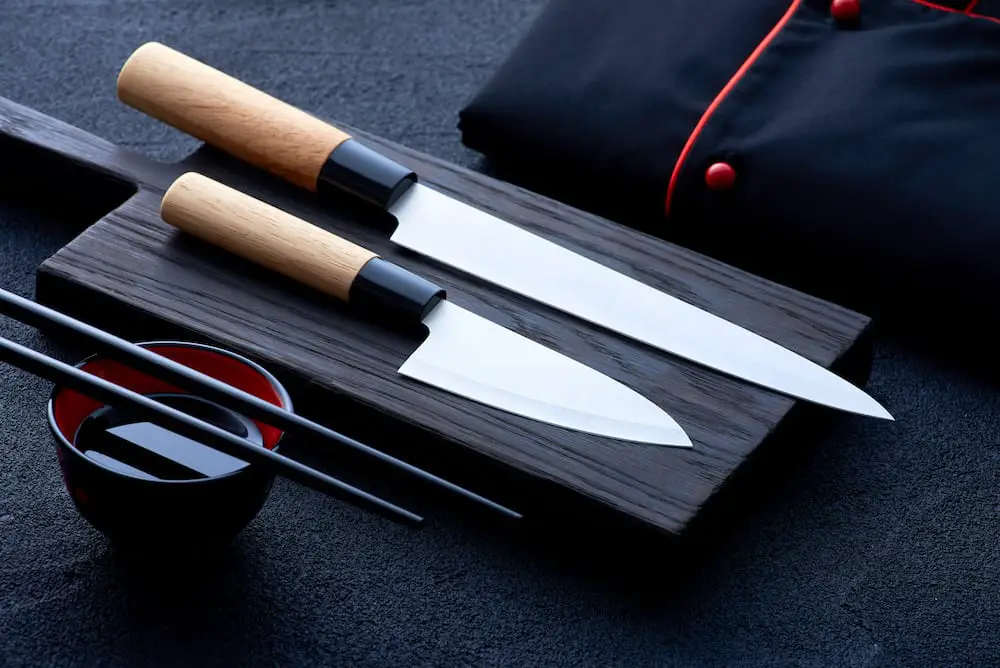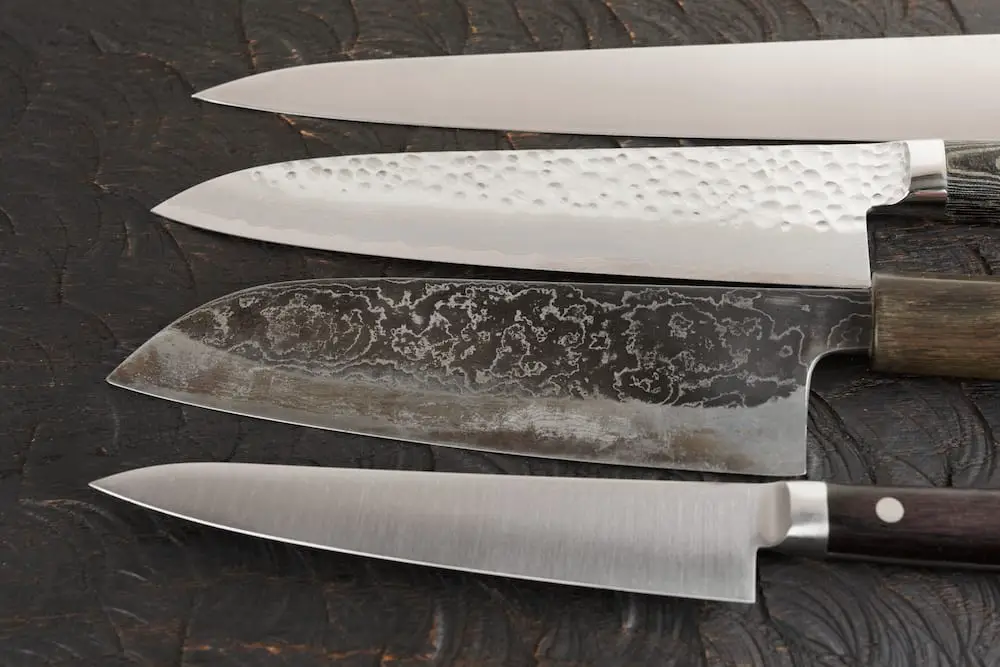Various cultures are adopting Japanese kitchen knives due to their unique blades and styles. If you spend a good amount of time in your kitchen, you may also want to give it a shot. So what makes Japanese knives so effective? To start with, these knives offer solid steel. You can find various types of Japanese knives today, and each of them serves a different purpose.
If you believe the myths, using knives as per their associated role helps in cooking pungent food. In case you’re completely blank about Japanese knives, you can keep reading this article.
Types of Japanese Knives: The 12 Popular Options
Here are some of the most popular Japanese knives available in the market:
Santoku
People can use a santoku knife for multiple purposes. They refer to this knife as the “variety knife” because it helps with slicing vegetables, fish, and meat. What makes it different is its thin flat blade that allows the user to cut huge slices of meat very easily.
Moreover, the blade is also sharper than the rest of the knives on this list, making it superior. Santoku is a general chopping knife that you definitely need to have at home.
Gyuto
Gyuto means “beef knife.” You can use it for chopping large slices of meat. Most people also refer to it as a chef’s knife. To your surprise, it has a very solid steel, due to which the thick blade makes chopping effortless.
This knife won’t put any pressure on your muscles and joints. You also have an option to select from a variety of blades, ranging from 200mm to 290mm. However, despite all of these features, there are still some tasks that this knife is unable to perform.
Nakiri
Nakiri is the most acclaimed vegetable knife due to its thin blade, which can help you with chopping and slicing vegetables to perfection. Chefs in Japan believe in nothing less than perfection, for which they use this knife for cutting vegetables.
If you believe there’s a hidden chef in you, then you can also grab this knife. It has a smooth blade, which makes sure that you can chop pumpkins and bell peppers conveniently.

Kiritsuke
Kiritsuke, widely known as the k-tip knife, has a very sharp edge. You can perform many food preparation tasks with it, including cutting, chopping, slicing.
You may wonder why, but this knife is not for everyone. It’s extremely sharp and has a slightly complex nature. Only professional chefs in Japan use kiritsuke knives at work.
You would notice that the majority of the homes don’t use this knife because people prefer using usuba and yanagi-ba. In any case, if you’re thinking of opening a restaurant, make sure it’s on the top of your list.
Deba
You possibly know that slicing beef, chicken, and fish is not like cutting a piece of cake. It involves a lot of muscular effort and hand power. For that, we recommend using a deba knife, which has a thicker blade than the rest of the options on this list.
It’s almost nine millimeters thick, which may trick you into believing that these knives are also suitable for cutting bones. Unfortunately, that is not true because cutting bones can damage its sharp edge.
The best part about this knife is that you can choose from different variations of deba knives. A hon-deba is one of the heaviest knives out there, while a kanisaki-deba can be used for chopping seafood, preferably crabs and lobsters.
Yanagiba
A yanagiba is a type of knife specially designed to be used for preparing Japanese dishes. It is very famous for its leaf-shaped blade. You can use it for slicing and skinning fish because the edged sharp blade delivers perfectly smooth curves.
You might be a huge fan of having raw fish, and a yanagiba’s long blade makes sure that the texture of the fish is maintained. It comes in various steels and blade sizes, allowing you to choose one according to your preferences.
Mukimono
Interested in fancy salads? Good news, the Japanese have knives associated for this purpose as well. Mukimono is a kind of Japanese knife used for cutting decorative vegetables. Because it has a small thin blade, it is perfect for subtle chopping and slicing.
All the cuts made using this knife are very smooth. What’s more, it’s not just for vegetables; you can also use this knife for peeling fruit.
Honesuki
Have you ever owned a knife with a traditional triangle-shaped blade? People across the globe have been using this knife for removing bones off of meat. The secret is, boning knives have extremely pointed tips, which means only cooking experts can use it correctly.
Also, if you wish to purchase any of these knives, keep in mind these are single-beveled knives and have different maintenance and usage techniques.
Usuba
Usuba has the thinnest blade among all the Japanese knives. It allows you to chop vegetables delicately. Not only that, but it also comes with a Japanese handle, due to which all expert chefs from all over the world use this knife for cutting vegetables. Your chores would become convenient thanks to the easy handling of the knife.
Unlike other knives, this is a single-beveled knife. You should know that it follows a different procedure when it comes to sharpening it. Nakiri serves the same purpose, but it’s a double-beveled knife. Make sure to check all the details carefully before you make a purchase.
Hankotsu
Typically, you must have observed butchers use hankotsu knife to extract the bones from the meat. It has a very narrow and sharp blade, which makes it feasible for you to get rid of all the bones from meat.
This knife comes with a comfy handle, which allows you to grip the knife tightly and securely. However, this knife doesn’t cut bones. Instead, it just removes the bones from the meat. You can use this knife to remove fats from the meat with minimal muscular power as well.
Takohiki
A takohiki knife has a straight blade with a square edge from the end. Chefs prefer using this knife for delicate cutting and slicing tasks. Sushi Chefs use this sushi knife mainly for lifting the meat.
You can refer to this like a fancy knife being used in restaurants. You must have noticed when chefs transfer meat to plates; more often than not, they use a takohiki knife for this purpose.
Garasuki
The secret is, garasuki knives are just like honesuki knives; they just differ in weight and size. Garasuki knives are heavier and larger.
Every chef in a fully occupied restaurant has this knife. It is mostly used to cut down whole, big, fat chickens due to its sharp edge and thick blade. It’s not something that you want to get it in your kitchen as only professional chefs use this sort of knife.
Conclusion
There are many more choices when it comes to the types of Japanese knives out there, each of them serving a different purpose. If you wish to grab a couple of Japanese knives to equip your kitchen, you can look into the options we have listed above, and get the ones that fit your requirements.

